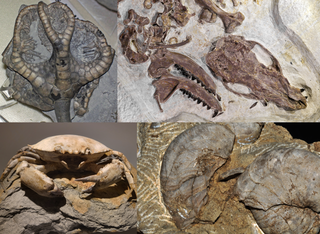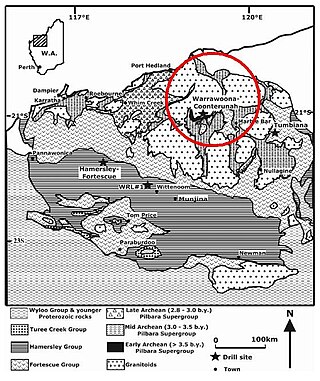
A fossil is any preserved remains, impression, or trace of any once-living thing from a past geological age. Examples include bones, shells, exoskeletons, stone imprints of animals or microbes, objects preserved in amber, hair, petrified wood and DNA remnants. The totality of fossils is known as the fossil record. Though the fossil record is incomplete, numerous studies have demonstrated that there is enough information available to give a good understanding of the pattern of diversification of life on Earth. In addition, the record can predict and fill gaps such as the discovery of Tiktaalik in the arctic of Canada.
The Precambrian is the earliest part of Earth's history, set before the current Phanerozoic Eon. The Precambrian is so named because it preceded the Cambrian, the first period of the Phanerozoic Eon, which is named after Cambria, the Latinized name for Wales, where rocks from this age were first studied. The Precambrian accounts for 88% of the Earth's geologic time.

Stromatolites or stromatoliths are layered sedimentary formations (microbialite) that are created mainly by photosynthetic microorganisms such as cyanobacteria, sulfate-reducing bacteria, and Pseudomonadota. These microorganisms produce adhesive compounds that cement sand and other rocky materials to form mineral "microbial mats". In turn, these mats build up layer by layer, growing gradually over time.

The Gunflint chert is a sequence of banded iron formation rocks that are exposed in the Gunflint Range of northern Minnesota and northwestern Ontario along the north shore of Lake Superior. The Gunflint Chert is of paleontological significance, as it contains evidence of microbial life from the Paleoproterozoic. The Gunflint Chert is composed of biogenic stromatolites. At the time of its discovery in the 1950s, it was the earliest form of life discovered and described in scientific literature, as well as the earliest evidence for photosynthesis. The black layers in the sequence contain microfossils that are 1.9 to 2.3 billion years in age. Stromatolite colonies of cyanobacteria that have converted to jasper are found in Ontario. The banded ironstone formation consists of alternating strata of iron oxide-rich layers interbedded with silica-rich zones. The iron oxides are typically hematite or magnetite with ilmenite, while the silicates are predominantly cryptocrystalline quartz as chert or jasper, along with some minor silicate minerals.

Paleobiology is an interdisciplinary field that combines the methods and findings found in both the earth sciences and the life sciences. Paleobiology is not to be confused with geobiology, which focuses more on the interactions between the biosphere and the physical Earth.
Elso Sterrenberg Barghoorn was an American paleobotanist, called by his student Andrew Knoll, the present Fisher Professor of Natural History at Harvard, "the father of Pre-Cambrian palaeontology."

Collenia is genus of fossil cyanobacteria that form a particular type of stromatolites.

The Ediacaranbiota is a taxonomic period classification that consists of all life forms that were present on Earth during the Ediacaran Period. These were enigmatic tubular and frond-shaped, mostly sessile, organisms. Trace fossils of these organisms have been found worldwide, and represent the earliest known complex multicellular organisms. The term "Ediacara biota" has received criticism from some scientists due to its alleged inconsistency, arbitrary exclusion of certain fossils, and inability to be precisely defined.
The Bitter Springs preservational mode is the preservation of microorganisms in silica, in shallow Precambrian waters.

The Warrawoona Group is a geological unit in Western Australia containing putative fossils of cyanobacteria cells. Dated 3.465 Ga, these microstructures, found in Archean chert, are considered to be the oldest known geological record of life on Earth.
The Poleta Formation is a geological unit known for the exceptional fossil preservation in the Indian Springs Lagerstätte, located in eastern California and Nevada.

Martin David Brasier FGS, FLS was an English palaeobiologist and astrobiologist known for his conceptual analysis of microfossils and evolution in the Precambrian and Cambrian.

The Barberton Greenstone Belt of eastern South Africa contains some of the most widely accepted fossil evidence for Archean life. These cell-sized prokaryote fossils are seen in the Barberton fossil record in rocks as old as 3.5 billion years. The Barberton Greenstone Belt is an excellent place to study the Archean Earth due to exposed sedimentary and metasedimentary rocks.
James William Schopf is an American paleobiologist and professor of earth sciences at the University of California Los Angeles. He is also Director of the Center for the Study of Evolution and the Origin of Life, and a member of the Department of Earth and Space Sciences, the Institute of Geophysics and Planetary Physics, and the Molecular Biology Institute at UCLA. He is most well known for his study of Precambrian prokaryotic life in Australia's Apex chert. Schopf has published extensively in the peer reviewed literature about the origins of life on Earth. He is the first to discover Precambrian microfossils in stromatolitic sediments of Australia (1965), South Africa (1966), Russia (1977), India (1978), and China (1984). He served as NASA's principal investigator of lunar samples during 1969–1974.
The Miette Group is an assemblage of metamorphosed sedimentary rocks of latest Precambrian (Neoproterozoic) age. It is present in the Canadian Cordillera from the Lake Louise area of Alberta to the Yukon. The Miette rocks include Ediacaran fossils, stromatolites, and trace fossils.

Kulpara is a rural town in South Australia, situated on the Copper Coast Highway and Upper Yorke Road in the Hummocks Range at the northern end of Yorke Peninsula.

The earliest known life forms on Earth may be as old as 4.1 billion years according to biologically fractionated graphite inside a single zircon grain in the Jack Hills range of Australia. The earliest evidence of life found in a stratigraphic unit, not just a single mineral grain, is the 3.7 Ga metasedimentary rocks containing graphite from the Isua Supracrustal Belt in Greenland. The earliest direct known life on land may be stromatolites which have been found in 3.480-billion-year-old geyserite uncovered in the Dresser Formation of the Pilbara Craton of Western Australia. Various microfossils of microorganisms have been found in 3.4 Ga rocks, including 3.465-billion-year-old Apex chert rocks from the same Australian craton region, and in 3.42 Ga hydrothermal vent precipitates from Barberton, South Africa. Much later in the geologic record, likely starting in 1.73 Ga, preserved molecular compounds of biologic origin are indicative of aerobic life. Therefore, the earliest time for the origin of life on Earth is at most 3.5 billion years ago, possibly as early as 4.1 billion years ago — not long after the oceans formed 4.5 billion years ago and after the formation of the Earth 4.54 billion years ago.
The Allamoore Formation is a Precambrian geologic formation found in the vicinity of Van Horn, Texas. The formation is notable for the well-preserved microfossils found in chert beds within the formation. These may include early eukaryotes. Possible fossil burrows were reported in the formation in 1995, which would push the origin of the first animals (Metazoa) back to before 1000 million years ago. However, these have since been explained as diagenetic structures, formed by nonbiological processes as the sediments making up the formation were compacted and lithified.
Kulparia is a genus of fossil stromatolite-forming cyanobacteria from the late Neoproterozoic era. It is named after the town of Kulpara in South Australia, where the type specimen was found nearby.

Conophyton is a genus of stromatolite-forming cyanobacteria from the Neoproterozoic era. Fossils have been found in many countries, including Australia, India, China and Russia.













